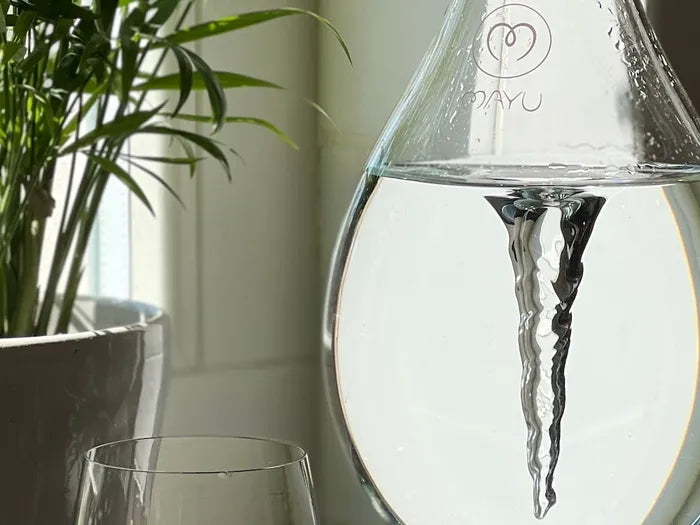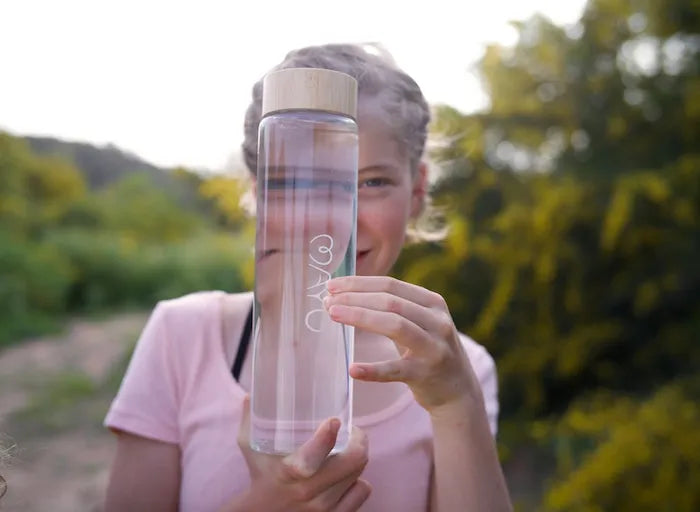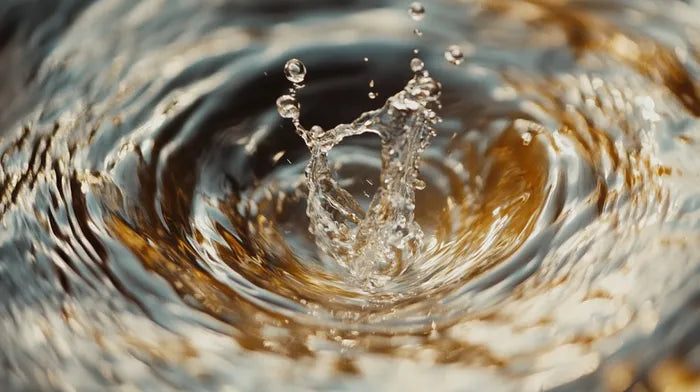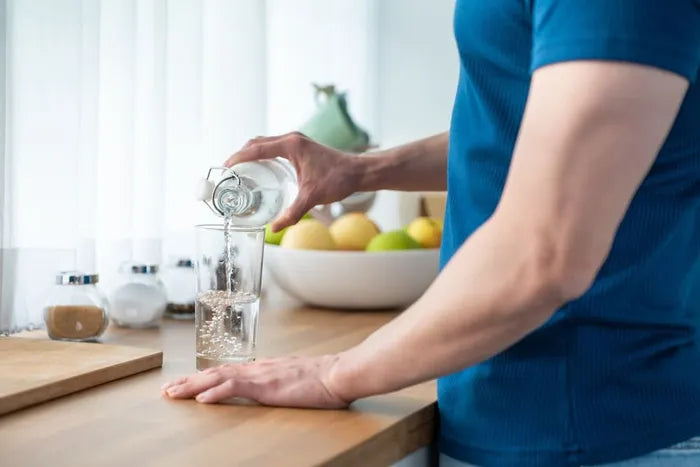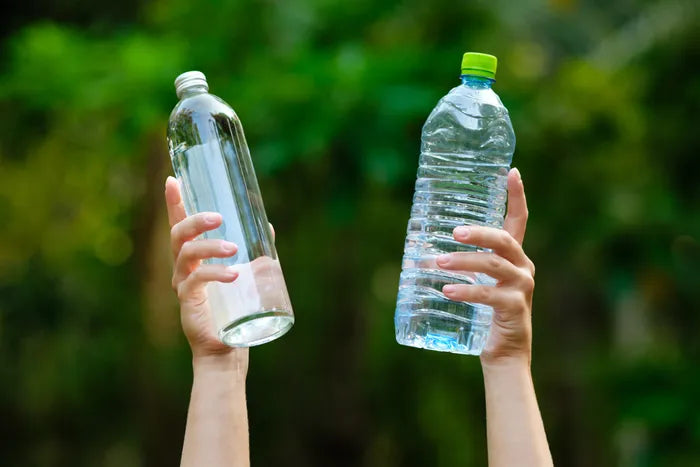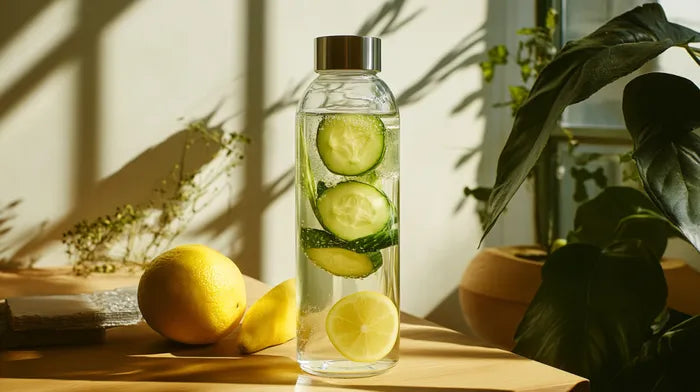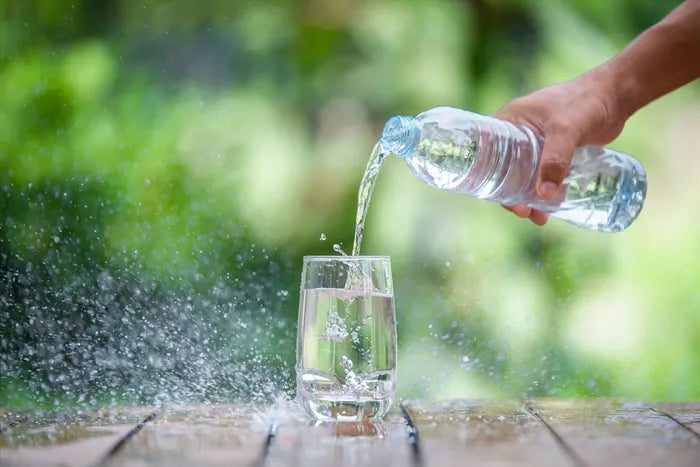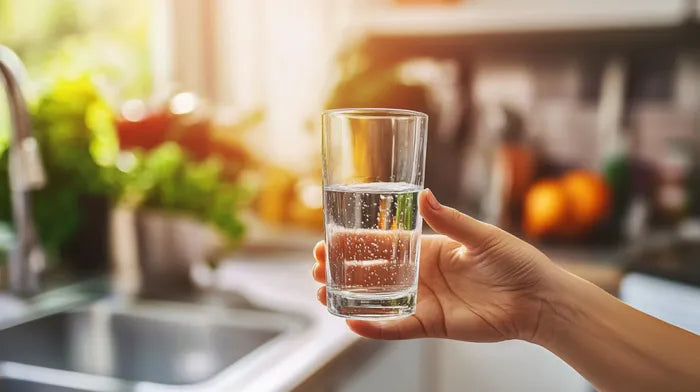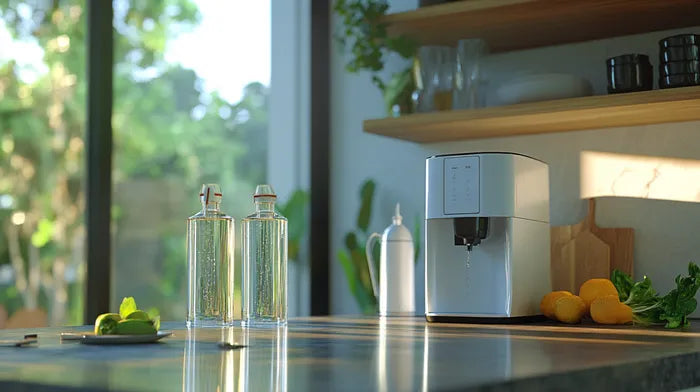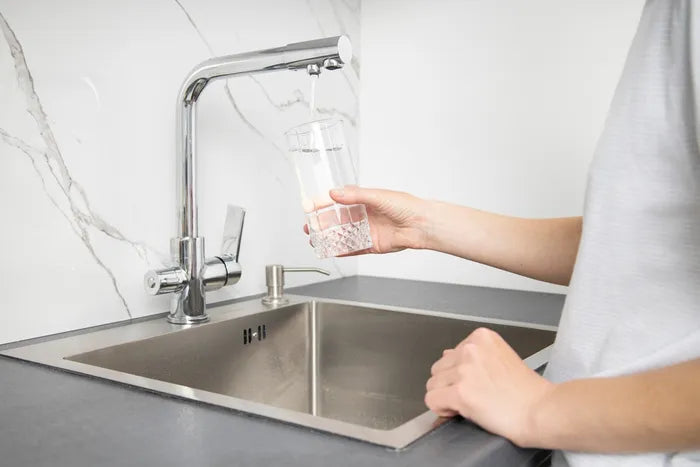How Aeration Prepares Water for Deeper Purification Steps
Aeration introduces air into water to strip harmful gases, oxidize dissolved metals like iron and manganese, and improve taste and clarity. This first step in water treatment makes all subsequent purification processes more effective while reducing the chemical costs by up to 40%.
Published September 13, 2025

Ever wonder why your water smells like rotten eggs or leaves rusty stains everywhere? The culprit isn't just what's in your water, it's what's missing: oxygen. This process, called aeration, gives your water a literal breath of fresh air.
Aeration on a chemical level strips away foul-smelling gases and transforms stubborn metals into particles that can be removed. It sets the stage for every purification step that follows. Let's look into why this simple process might be exactly what your water needs.
» Learn more about aerated water and its benefits
What Is Water Aeration?
Think of aeration as water's wake-up call. It's the process where air gets introduced into water so gases can transfer between the air and water phases. But this isn't just bubbling air through water; it's a carefully engineered dance of physics.
Physical Processes at Work During Water Aeration
- Diffusion: Gases naturally move from high concentration areas to low ones.
- Bubble Dynamics: Air bubbles form, rise, and dissolve, carrying contaminants with them.
- Turbulent Mixing: Water movement breaks down boundary layers, speeding up gas transfer.
- Surface Expansion: More water surface area means faster gas exchange.
- Pressure Effects: Deeper water holds more dissolved gases under pressure.
The Science Made Simple: When air meets water under the right conditions, unwanted dissolved gases like carbon dioxide and hydrogen sulfide get stripped away, while oxygen moves in.
At the same time, dissolved metals like iron and manganese get oxidized; basically, they rust instantly and turn into particles that can be easily filtered out.
Drinking Water vs. Industrial Aeration Water
For Your Drinking Water
Aeration acts like a pre-wash cycle for your water. It's applied early in treatment to strip unwanted gases (think rotten egg smell from hydrogen sulfide), remove taste-affecting compounds, and oxidize metals like iron and manganese so they can be filtered out. The goal? Making water safe, clear, and pleasant to drink.
For Wastewater Treatment
Here, aeration is the main event. Massive amounts of oxygen get pumped into wastewater to feed hungry microorganisms that break down organic matter. It's like creating an underwater ecosystem designed to eat pollution.
The Key Difference: Drinking water aeration uses short, targeted bursts to fix specific problems. Wastewater aeration runs continuously to sustain biological processes. Same physics, but completely different applications.
» Learn about reverse osmosis vs. purified water treatment methods
When Does Your Water Need Aeration?
Certain warning signs will show that your water needs to breathe:
- The Smell Test: If your water smells like rotten eggs, sewage, or has that musty basement odor, dissolved gases are likely the culprit. Aeration can strip these away in minutes.
- The Color Check: Rusty, yellow, or black-tinted water usually means dissolved iron or manganese. Once aerated, these metals oxidize and can be filtered out, leaving crystal-clear water.
- The Taste Factor: Water that tastes sour, metallic, or just "off" often has excess carbon dioxide, hidden contaminants, or dissolved metals. Aeration balances the chemistry and improves taste dramatically.
- The Chemistry Signs: High CO₂, low pH, or corrosive water conditions all point to aeration as a solution. Groundwater especially benefits since it's naturally oxygen-poor.
Where Aeration Fits in the Water Treatment Process
Aeration typically comes first, right at the beginning of treatment for your drinking water. Why? It's like clearing the stage before the main performance.
By removing gases and oxidizing metals early, every subsequent step, coagulation, filtration, and disinfection work better and more efficiently.
When aeration happens first, it optimizes chemical conditions for everything that follows. The pH level of water gets balanced, organic compounds get stripped, and metals get converted into filterable forms. It's the difference between trying to clean a dirty window with muddy water versus clean water.
» Discover the best water filters for smelly water elimination
How Different Water Aeration Systems Work
- Cascade Aerators: Picture a beautiful waterfall, but engineered for maximum air contact. Water tumbles over steps or weirs, mixing with air naturally. It's simple, effective, and energy-efficient for smaller systems.
- Spray Aerators: Like giant lawn sprinklers that shoot water high into the air. As droplets fall back down, they absorb oxygen and release unwanted gases. It's great for iron and manganese removal.
- Packed Tower Aerators: Think of a tall tower filled with plastic media that looks like pasta. Water trickles down while air flows up, maximizing contact time. These are workhorses for volatile compound removal.
- Diffused Bubble Systems: Air gets pumped through diffusers at the bottom of a tank, creating millions of tiny bubbles that rise through the water. It's efficient for deep tanks and high-volume treatment.
- Venturi Aerators: These use water pressure to create suction that pulls air into the system. The high-speed mixing creates incredibly fine bubbles for maximum gas transfer.
How Aeration Supercharges Other Water Treatment Steps
Here's where aeration really shines, it makes every other treatment process work better and cost less.
Studies show aeration can cut chlorine demand by 30-40% because many organic compounds get stripped away first, meaning less chemical usage and lower operating costs [1].
Certain minerals in tap water, like iron and manganese, get oxidized by aeration, and they form particles that filters can actually catch, whereas without aeration, these dissolved metals would pass right through most filters.
Research shows that aeration can remove 90-98% of dissolved iron and manganese when followed by proper filtration [2]. By removing excess CO₂, aeration naturally raises pH, making water less corrosive to pipes and more chemically stable for further treatment.
» Discover how to eliminate microplastics with effective water filters
Aerated Water Quality Improvements You Can See and Taste
- Aeration removes the rusty color from iron, the black tinge from manganese, and eliminates cloudiness. The result? Water that looks like it should.
- Higher oxygen content gives water that crisp, fresh taste. No more metallic aftertastes or sour notes from excess CO₂.
- Say goodbye to rotten egg smells from hydrogen sulfide or musty odors from other dissolved gases. Aerated water smells like... nothing, which is exactly how clean water should smell. Chloroform gases are also removed as aeration removes chlorine.
- With balanced pH and reduced corrosiveness, aerated water is gentler on your plumbing compared to the effects of hard water and provides a stable foundation for any additional treatment.
» Find the best water filters for hard water treatment
Types of Water Where Aeration Works Best
- Groundwater Sources: Wells and springs are the aeration's sweet spot. These water sources are naturally low in oxygen, making dissolved gases and reduced metals common problems that aeration solves perfectly.
- Stagnant Water Bodies: Lakes, ponds, and reservoirs benefit hugely from aeration. It prevents stratification, reduces algae growth, and maintains healthy dissolved oxygen levels for aquatic life.
- High-Contaminant Sources: Water heavily polluted with organic volatiles or specific gases may need aeration before biological treatment can be effective.
- Cold Climate Consideration: Aeration works best in moderate temperatures. Very cold water holds gases more tightly, making the process less efficient, though still beneficial.
What Aeration Can't Do for Water
Aeration isn't a magic bullet that fixes every water problem. It only affects volatile compounds and metals that can be oxidized; heavy metals like lead or arsenic in tap water aren't going anywhere with simple aeration.
They need one of the most efficient methods of purification.
Cold water presents challenges, too, as dissolved gases become stubborn and don't want to leave, making aeration less economical and effective in frigid conditions.
While aeration excels at removing high concentrations of contaminants, getting those final traces out requires exponentially more energy and time.
Large-scale aeration systems also need significant power for blowers, pumps, and mixing equipment, so while it's typically cost-effective, it's not free to operate.
» Explore tap water filter vs. reverse osmosis safety options
Health Benefits of Aerated and Purified Water
- Toxin Removal: Aeration effectively strips radon gas and many volatile organic compounds, reducing cancer risk by removing contaminants in drinking water.
- Metal Management: By precipitating iron and manganese, aeration removes these metals that can cause health issues at high levels and definitely cause taste problems at any level.
- Indirect Protection: By raising pH slightly, aerated water becomes less corrosive, meaning fewer heavy metals get leached from pipes into your drinking water.
- Improved Palatability: Better-tasting water encourages proper hydration, which supports overall health in countless ways.
» Find out if drinking filtered water is good for your health
Can You DIY Water Aeration?
Understanding your options for water aeration helps you make informed decisions about whether to go professional or try simpler approaches for your water treatment needs.
Emergency DIY Water Aeration
In a pinch, vigorous shaking or stirring can introduce tiny amounts of air into water. Think of it like manually carbonating water, but in reverse, you're trying to add oxygen instead of CO₂.
This manual approach is extremely inefficient, though. You might make water taste slightly fresher by adding a bit of oxygen, but you won't meaningfully remove contaminants or improve safety.
It's better than nothing for taste, but don't count on it for actual purification. Boiling water to purify it, proper filtration, or water purification tablets are far more effective for emergency water safety.
Home vs. Municipal Water Aeration Systems
Compact home units designed for residential wells typically handle a few gallons per minute and are often combined with filters, sized for specific problems like hydrogen sulfide or iron removal.
Municipal plants operate on an entirely different scale, with industrial-scale systems processing thousands of gallons per minute using massive cascade towers, diffuser systems, or mechanical aerators running 24/7.
The maintenance reality differs dramatically, too. Home units need regular attention, like cleaning diffusers, checking pumps, and replacing filters, while municipal systems require professional operation but handle the heavy lifting for entire communities.
Natural vs. Engineered Water Aeration
Streams tumbling over rocks, wind mixing lake surfaces, and waterfalls all provide natural aeration that's free, beautiful, and variable depending on weather and geography.
Treatment plants can dial in exact oxygen levels, target specific depths, and maintain consistent performance regardless of weather—much more control, but it costs energy and money.
Natural aeration works wonderfully for surface water bodies, but when you need reliable, consistent water treatment, engineered systems deliver results you can count on.
» Learn about reverse osmosis vs. carbon water filter effectiveness
The Bottom Line: Aeration Sets the Foundation
Aeration might not get the spotlight like reverse osmosis or UV sterilization, but it does help everything else work better. It removes the problems that would otherwise clog the water filter you use, consume chemicals, and leave you with water that tastes and smells terrible.
Whether you're dealing with smelly well water at home or designing a municipal treatment plant, aeration is often the smart first step. It's cost-effective, reliable, and creates the foundation for whatever treatment follows.
Ready to give your water the breath of fresh air it deserves? The MAYU Swirl creates a natural vortex that aerates your water while enhancing its structure, mimicking the way water moves in nature to improve both oxygenation and taste.
References
Sadrnourmohamadi, M. (2017, July 28). Does post-aeration affect the level of chlorine residual in water distribution system? ResearchGate. https://www.researchgate.net/post/does_post-aeration_affect_the_level_of_chlorine_residual_in_water_distribution_system
Vries, D., Bertelkamp, C., Schoonenberg Kegel, F., Hofs, B., & Dusseldorp, J. (2017, February 1). Iron and manganese removal: Recent advances in modelling treatment efficiency by rapid sand filtration. ScienceDirect. https://www.sciencedirect.com/science/article/abs/pii/S0043135416308703
Disclaimer: The information published by MAYU Water is not a substitute for the expert knowledge, advice, and recommendations of trained professionals. We strongly recommend consulting with industry experts and primary or scientific sources before making any health, research-related, or other important decisions.
FAQs
Does aeration remove all contaminants from water?
No, aeration only removes volatile compounds and oxidizes certain metals. It won't eliminate bacteria, viruses, heavy metals like lead, or dissolved minerals. Aeration is typically the first step in a comprehensive treatment process.
How long does the aeration process take?
Contact time varies by system and contaminants. Spray aerators work in minutes, while packed towers may need 10-30 minutes of contact time. The key is achieving equilibrium between air and water phases.
Can aeration make water too oxygenated?
Not really. Water reaches natural saturation levels with oxygen, and excess simply escapes back to the atmosphere. High oxygen content in drinking water is generally beneficial, not harmful.
Is aerated water safe to drink immediately?
Yes, properly aerated water is safe to drink. However, if the source had bacterial contamination, aeration alone won't eliminate pathogens. Additional disinfection would be needed for complete safety.












